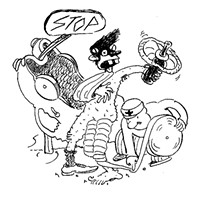You've already tackled the question of whether penis size differs by race [Jan. 11, 1985]. Now I've got another question concerning a racial stereotype: I'm sure almost everyone has heard a stereotype about bad driving—the most common being that Asians are bad drivers, but I've heard the same said about almost every race. I personally think bad driving is universal. Although car-insurance companies openly discriminate based on age and gender, I don't think they are allowed to do so based on race—but I bet they still have the figures to prove whether racial stereotypes about bad driving are true or not. What's the straight dope? Do certain races stand out as worse drivers than others? —Jim, Baltimore
I'm always happy to answer the questions of such a well-read individual. You're right about auto insurance—companies aren't allowed to openly discriminate based on race. However, they can vary their prices by zip code, which often ends up having the same effect: car-insurance customers in largely black Detroit, for instance, may pay twice as much as those in the whiter suburbs that surround it. Is this based on some secret set of data, collected by an army of Edward Norton-in-Fight Club types, showing that minorities are worse drivers? As with the Vatican's porn collection, we can't prove it's not there. Looking at public data, however, we've arrived at different conclusions.
The most reliable information comes from the National Highway Traffic Safety Administration, which has recorded traffic fatalities by race since 1999 (also providing in the process a record of American bureaucracy's often awkward struggle to label ethnic groups consistently). The evidence shows that first of all, this is a pretty significant issue: driving accidents are the leading cause of death for all races ages 4 to 34 (the 4-year-olds were passengers, not drivers, before you start getting smart). That said, in 2006 (for example) the crash fatality rates for the Hispanic, white, and African American populations were very similar—12.27, 12.50, and 12.31 deaths per 100,000 people, respectively. The real differences show up with Asians—whose fatality rate was only 4.00 deaths per 100,000—and Native Americans, whose rate was more than twice the national average, at 31.17.
Much of this has to do with alcohol use. Asians consistently have lower rates of heavy and binge drinking than any other minority population, while those rates among Native Americans are much higher. (For the record, whites have easily the highest rates of overall alcohol use.) As a consequence, more than half of Native American driving fatalities occurred when the driver was inebriated. For Asians, this number was barely above 20 percent.
This doesn't account for less serious but still unsafe driving practices like speeding. Unlike the clear-cut facts of driving fatalities, however, data involving police practices allows much more room for subjectivity and bias. For instance, Justice Department statisticians tell us that in 2011, black drivers were more likely to get stopped by police than white, Hispanic and Asian drivers, and blacks were also more often ticketed. However, among all drivers stopped, they were also the most likely to be allowed to proceed without receiving a ticket—arguably suggesting that police more often stop black drivers without evidence of wrongdoing.
In any case, evidence supporting the idea that Asians are bad drivers is remarkably difficult to come by. Researchers at the University of Sydney reported in 2010 that among drivers aged 25 and younger, the crash risk of Asian-born drivers is actually about half that of Australian-born drivers. Lest readers immediately lampoon the native-born Australians for being too liberal with the Foster's, these results were replicated in a 2011 Canadian study, where researchers found that recent immigrants (largely from China and India) were 40 to 50 percent less likely than long-term residents to be involved in a crash.
So where does this clearly delusional fear of Asians in cars come from? Perhaps because driving in Asia, regardless of your ethnicity, is legitimately terrifying. It's believed that more than 150,000 people die annually as a result of road accidents in India alone. (Which honestly may not sound like a lot in a country of 1.24 billion, but think of it this way: according to one estimate, India has 1 percent of the world's motor vehicles but 15 percent of the traffic fatalities.) That's likely a result of the fact that Asian countries are among the fastest-developing in the world, meaning more and more people are owning vehicles—in Southeast Asia, the number of registered vehicles has jumped by nearly a third in just four years. These cars are often crammed with far more people than in long-industrialized countries, resulting in more deaths when they crash. Road infrastructure and traffic-safety regulations in most countries have also not kept up with the increased traffic.
The bad-Asian-driver myth can now be classified as (if I may say so) officially debunked. Shall we consolidate the information here with the data we already have about racial differences to see if penis size correlates with risky road behavior? Maybe next week.
Send questions to Cecil via StraightDope.com or write him c/o Chicago Reader, 350 N. Orleans, Chicago 60654.
More by Cecil Adams
-
This Is the End, My Friend
This week's Straight Dope marks the last appearance of the column as the Teeming Millions have known it for the past 45 years.
- Jul 11, 2018
-
Do Brain Supplements Do Anything?
Brain Drain
- Jul 4, 2018
-
Is flying really worse for the environment than driving?
Planes and Trains
- Jun 27, 2018
- More »




